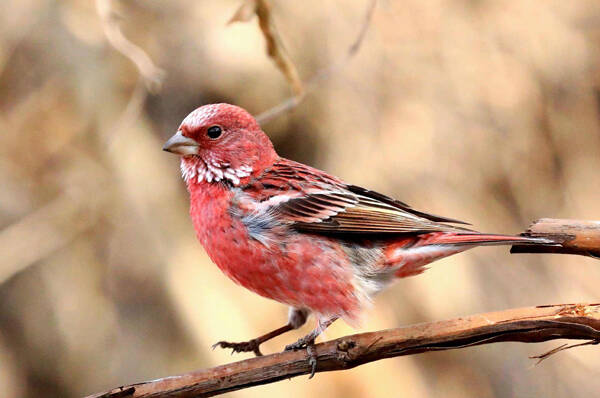Carpodacus roseus
IUCN
LCBasic Information
Scientific classification
- name:Carpodacus roseus
- Scientific Name:Carpodacus roseus,Pallas's Rosefinch,Tit
- Outline:Songbird
- Family:Passeriformes Fringillidae Redfinch
Vital signs
- length:14-18cm
- Weight:19-30g
- lifetime:5-10years
Feature
With beautiful feathers, pleasant singing voice, and easy to raise and tame, it is one of the most common cage birds in China.
Distribution and Habitat
Origin: China, Japan, Kazakhstan, Democratic People's Republic of Korea, Republic of Korea, Mongolia, Russian Federation.
Wandering: Denmark, Hungary
Distribution in China: Jilin (Changbai Mountain, Laoyeling, Changchun, Liaoyuan), Liaoning (Dandong, Caohekou), Inner Mongolia (Hulunbuir League, Daxing'anling, Chifeng), Ningxia (Zhongwei, Yinchuan, Helan Mountain), Gansu (eastern Qilian Mountain, Sunan, southeastern Tianshui, southwestern Zhuoni, Maqu, Zhouqu), Hebei, Shaanxi, Shanxi, Shandong, Henan, Jiangsu (Zhenjiang, Shaweishan Island), Heilongjiang (Harbin).
During the breeding period, it inhabits the open subalpine shrub grasslands on the upper edge of the forest belt, the rhododendron shrubs on the upper edge of the forest with sparse trees, and the shrubbed birch forests, pine and other dwarf shrub forests and taiga forests. During the non-breeding period, it inhabits different forest types and shrubs such as coniferous and broad-leaved mixed forests, broad-le
Appearance
The forehead and the front of the head of the male bird are pearly white with narrow pink feather edges, forming very obvious silvery white scaly spots on the front of the head, and the back of the head, occiput, head side and back neck are pink. The back and shoulders are brown with dark brown feather stem stripes and pink feather edges. The waist and tail coverts are bright pink without dark brown vertical stripes. The tail feathers are dark brown and the outer feathers are pink, the wings are dark brown, the flight feathers have red edges, the outer feathers of the small coverts on the wings are pink, the middle coverts and large coverts have white and pink end spots. Two wing spots are formed on the wings. The cheeks, chin, and throat are silvery white with narrow pink feather edges, forming the same silvery white scaly spots as the forehead. The rest of the lower body is pink, the center of the abdomen is white, and the axillary feathers and underwing coverts are white with a hint
Details
Pallas's Rosefinch, also known as Pallas's Rosefinch, has two subspecies.

Except for the breeding season, the Northern Redbirds usually live in groups in other seasons, but the groups are not large, with small groups of 5-8 or more than 10 birds. Sometimes they are seen in mixed groups and foraging with other small birds such as the Tin-billed Sparrow and the Long-tailed Redbird. They are alert and good at hiding. They usually stand on the top branches of tall trees or shrubs. They only go down to the grass or bushes when looking for food. If disturbed, they will fly away immediately and make a monotonous and weak "zhi" sound. During the breeding period, their calls are louder and more melodious.
The Northern Redbird mainly feeds on grass seeds and shrub seeds, such as Rosa thorna, Vitex schisandrae, Schisandra chinensis, and Rhododendron chinense. It also eats tree seeds and crop seeds such as pine nuts and rice.
The Northern Redbird breeds in eastern and central Siberia, with a breeding season from May to July. It usually begins to separate into pairs soon after arriving at the breeding grounds. The male bird stands on the top branches of small trees or shrubs and sings, and occasionally jumps and flies between the upper and lower branches, or flies from one tree to another nearby tree. The female bird flies and stands on the low branches or on the ground below the male bird. Mating also takes place on low branches or on the ground. The nest is built in thorny bushes such as roses and on small branches. It is 0.5-1 meters above the ground and is relatively hidden. The nest is cup-shaped and has a loose structure. It is made of materials such as dead grass stems, grass leaves and fibrous roots, and is padded with fine fibrous roots and a small amount of animal hair. The nest is built by the female bird alone, and the male bird sings and guards near the nest. Each nest lays 3-6 eggs. The female bird is responsible for incubation, and the male bird feeds the female bird during the incubation period. The incubation period is 13-14 days. The chicks are late-maturing, and the male and female parents raise them together. After 15-17 days of feeding, the chicks can leave the nest.
Listed in the "Red List of Endangered Species of the World Conservation Union" (IUCN) 2018 ver 3.1-Least Concern (LC).
Listed in the "List of Terrestrial Wildlife with Important Economic and Scientific Research Value under State Protection" (Item 661) issued by the State Forestry Administration of China on August 1, 2000.
Listed in China's "National Key Protected Wildlife List" (February 5, 2021) Level 2.
Protect wildlife and eliminate game.
Maintaining ecological balance is everyone's responsibility!








